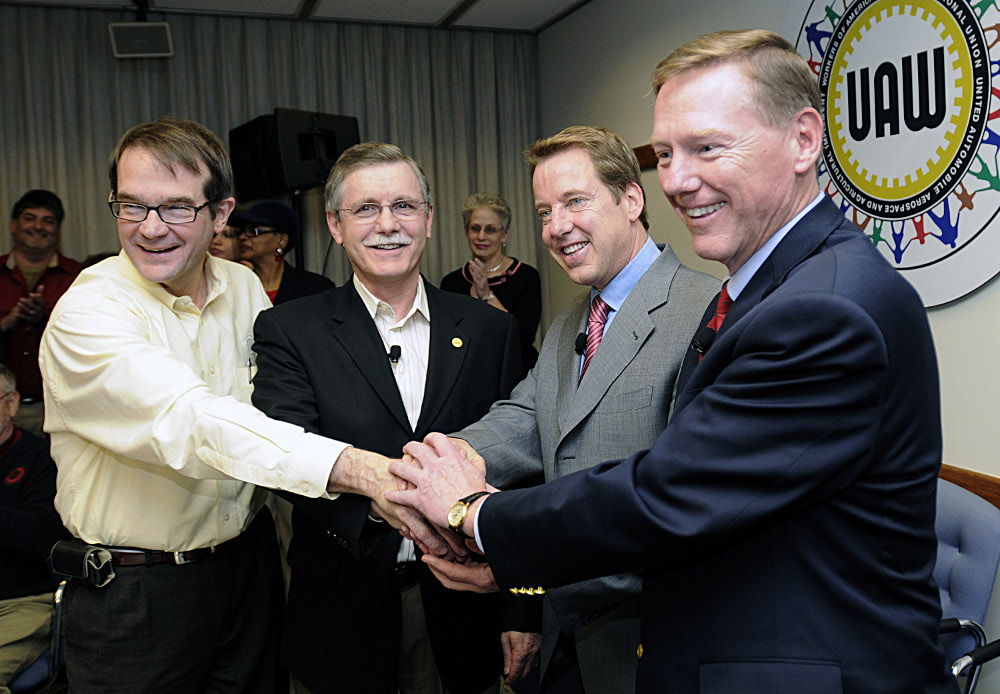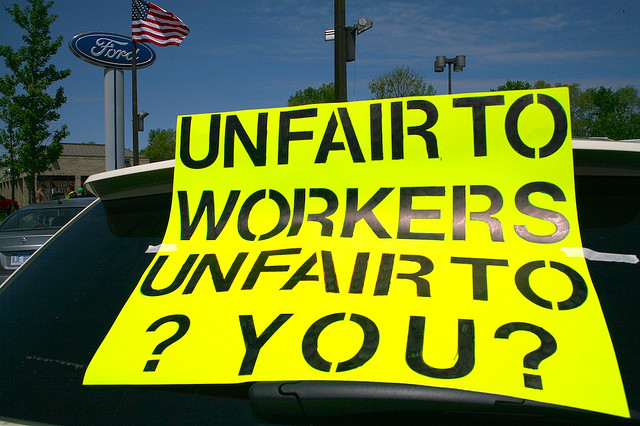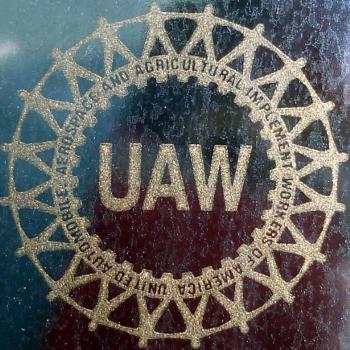Amid mostly worrying news on the economy, one bright spot has emerged over the past two months. Ford, GM and Chrysler, the long-troubled “Big Three” auto makers, have seen big increases in profits and are adding new jobs, investing in, and expanding plants. The business media credits the “fresh thinking” of new management for the turnaround. But auto workers know better after more than 5 years of massive concessions and layoffs. So, we’re left to wonder: if there was “shared sacrifice” during hard times, shouldn’t there be shared gain when things improve?
The auto industry is an important part of the US economy and auto workers, represented in the Big Three by the UAW, are a key component of the labor movement. After waging struggles in the past such as the Flint “sit down strike” in 1936-37 and the national GM strike in 1945, workers in the Big Three became the most highly organized group of workers in the country. This allowed auto workers to become one of the best paid sectors of the working class with comparably good working conditions. These gains also set the pattern for what was expected in terms of wages and benefits for other US workers, especially industrial workers.
In other words, better pay and conditions for one segment of the working class “raises all boats.” For decades, the Federal Reserve even kept a close watch on UAW contracts because auto workers’ wages were the best indicator of wage trends across the board. Because of this key position, the UAW has been a major target not just for the auto execs and the big shareholders, but for the entire ruling class for decades.
 Flint 1937 sit-down strike. Photo: Farm Security Administration Since the early 1980s, the bosses have carried out a concerted campaign to whittle away at the UAW through plant closings and cutbacks, with the full backing of both parties in government. In 1979, the UAW had 1.5 million members. By 2009, this had dropped to 390,000. Between 2000 and 2008, the number of Big Three assembly plants dropped from 66 to 40, while their combined manufacturing capacity went from 13.7 million vehicles per year to just 8 million.
Flint 1937 sit-down strike. Photo: Farm Security Administration Since the early 1980s, the bosses have carried out a concerted campaign to whittle away at the UAW through plant closings and cutbacks, with the full backing of both parties in government. In 1979, the UAW had 1.5 million members. By 2009, this had dropped to 390,000. Between 2000 and 2008, the number of Big Three assembly plants dropped from 66 to 40, while their combined manufacturing capacity went from 13.7 million vehicles per year to just 8 million.
In 2008, GM and Chrysler, the largest and third largest US auto makers respectively, filed bankruptcy after several years of gross mismanagement and profiteering. The Obama administration and Congress bailed them out, but only on condition of further “restructuring” (more layoffs and concessions from the workers).
$62 billion in public money was handed over to GM and Chrysler, which emerged from Chapter 11 bankruptcy in 2009, and are now raking in profits. Then-UAW President Ron Gettelfinger agreed to “share the burden” with management and pushed hard for more concessions from the workers he was supposed to represent. This was on top of the concession-ridden 2008 national agreement with the Big Three that slashed wages to non-union US Toyota levels, as well as the union agreeing to assume 100% of health care costs for workers and retirees.
The UAW did gain 55% ownership of Chrysler, but on the whole, workers regarded the contract as a massive giveaway forced on them under pressure. Not surprisingly, Gettlefinger was voted out of office in 2009. He was replaced by Bob King, a UAW vice-president for the Ford division who promised to fight back to recover what was lost when the next industry-wide contract talks begin next year.
 Bob King (far left) and Ron Gettelfinger (left) signing agreement with Ford management (right) in 2007. Photo: Ford Motor Cars Quoted in the New York Times after his election in May, King said that “When there’s equality of sacrifice, there’s got to be equality of gain... We just want to make sure when things turn around we share in the upside.’’ Things have certainly started to turn around, but not surprisingly, the bosses aren’t sharing.
Bob King (far left) and Ron Gettelfinger (left) signing agreement with Ford management (right) in 2007. Photo: Ford Motor Cars Quoted in the New York Times after his election in May, King said that “When there’s equality of sacrifice, there’s got to be equality of gain... We just want to make sure when things turn around we share in the upside.’’ Things have certainly started to turn around, but not surprisingly, the bosses aren’t sharing.
Ford, the only member of the Big Three to avoid bankruptcy, has now become the biggest of the three. Ford earned $1.7 billion in the third quarter of 2010, and says it will have zero debt by December. Ford has made more profits in just the first six months of 2010 than it did in the previous 5 years.
According to the New York Times, GM and Chrysler are not far behind: “G.M. is profitable and preparing for one of the biggest public stock offerings in American history. Even Chrysler, the auto maker thought least likely to survive the recession, is hiring new workers.” While the Big Three’s share of the North American car market has dropped to 46%, for the first time in more than a decade, its cars are selling at higher prices as compared to the non-US makers.
As reported in the NYT:
“The proof is emerging in dealer showrooms, where customers are buying more of Detroit’s cars and paying higher prices. In July, G.M., Ford and Chrysler sold their vehicles at an average price of $30,400 -- $1,350 more than a year ago and higher than an overall industry gain of $1,100, according to the auto research Web site Edmunds.com.”
Each of the Big Three have also scaled back rebates and other incentives for buyers.
GM and Chrysler have added 55,000 new jobs. Ford is adding jobs and expanding Michigan plants, too. But these are not the same jobs as those that were lost in 2008. A two-tier wage system in now place, which means that these new workers earn roughly just half of pre-2008 workers, even if they are doing the exact same job. Entry-level GM production workers get $14/hour, and for the first time since the 1940s, there are many auto workers whose pay is not enough to make basic ends meet. Poverty in America estimates that in Saginaw county, Michigan, for example, a living wage for a worker supporting one adult dependent (without children) would be $13.00/hour. For the same worker to support one adult and just one child however, $16.59/hour would be needed. In 2006, before the two-tier system, new hires at GM made 74% more than the national average wage; in 2010, new GM workers make 20% less than the national average.
All of this adds up to a fighting mood in the UAW rank and file. Saladin Parm, who has worked 23 years at a GM plant in Saginaw, Michigan, told a Businessweek reporter that workers on the shop floor are the angriest he’s ever seen:
“They’re saying, ‘This is not a high-school job where I want to take my girlfriend out to the movies. I have to support my family on this’... I have a lot of faith in our union. My dad came up from the South to make a better living in the auto plants, and he did. That’s why it’s hard to fathom what I’m seeing. I never dreamed I’d be seeing tears.”
 Photo: babblingdweeb After voting Gettelfinger out last year, the rank and file signaled that it had had enough of concessions. The new leadership has said that it will roll back concessions when the 2011 contract talks open. If the auto workers begin to fight back, this would set an example for the rest of the working class. For the past 30 years, the UAW has been under attack by the bosses and time after time the UAW has given concession after concession in the name of “jointness,” the idea that what is good for the company is good for the workers. A serious discussion inside the union about its philosophy is needed if auto workers want to reverse the concessions tide.
Photo: babblingdweeb After voting Gettelfinger out last year, the rank and file signaled that it had had enough of concessions. The new leadership has said that it will roll back concessions when the 2011 contract talks open. If the auto workers begin to fight back, this would set an example for the rest of the working class. For the past 30 years, the UAW has been under attack by the bosses and time after time the UAW has given concession after concession in the name of “jointness,” the idea that what is good for the company is good for the workers. A serious discussion inside the union about its philosophy is needed if auto workers want to reverse the concessions tide.
The Marxists in the labor movement consistently put forward that the unions should adopt class struggle unionism as its philosophy. This is the idea that the bosses and the workers have no interests in common. This kind of thing isn’t alien to the UAW -- it is part of the union’s history. There are many examples, from the sit down strikes in Flint to the national GM strike in 1945, where workers shut down each and every GM plant in the country.
Revolutionary ideas are also not foreign to the UAW. It was auto worker members of the Communist Party who in the 1930s spearheaded the first organizing drives and participated as shop floor leaders of many strikes, and the Muste-ite Socialists who led the Toledo Auto Lite strike in 1934. Even Walter and Victor Reuther, considered the “founding fathers” of the modern UAW, described themselves as socialists in their youth (they even worked for two years in a Soviet auto plant in Gorky, Russia from 1933-35). Despite “softening” their radicalism in the 1950s and 60s, they still supported UAW policy calling for free, publicly-funded universal health care for all and committing the UAW to fighting in the interests of the working class as a whole. The revolutionary ideas held by auto workers in the past and class struggle methods are even more important and relevant today and for the future.
Many in the UAW have gone along with “jointness” for decades, but now they can see the bottom and have no where else to go but to fight. In addition, the UAW has gained 55,000 new members who have no experience of past defeats and who would be prepared to fight if the union leaders were to show a way forward. The UAW was born out class struggle and bold industrial strike action, and to meet the challenges of the future, it needs to return to its militant roots.
Source: Socialist Appeal (USA)

